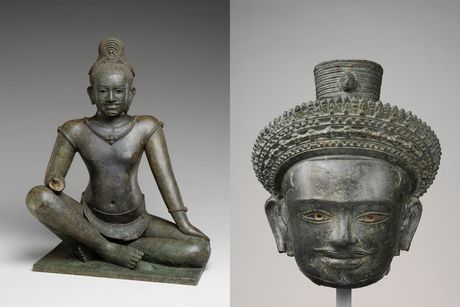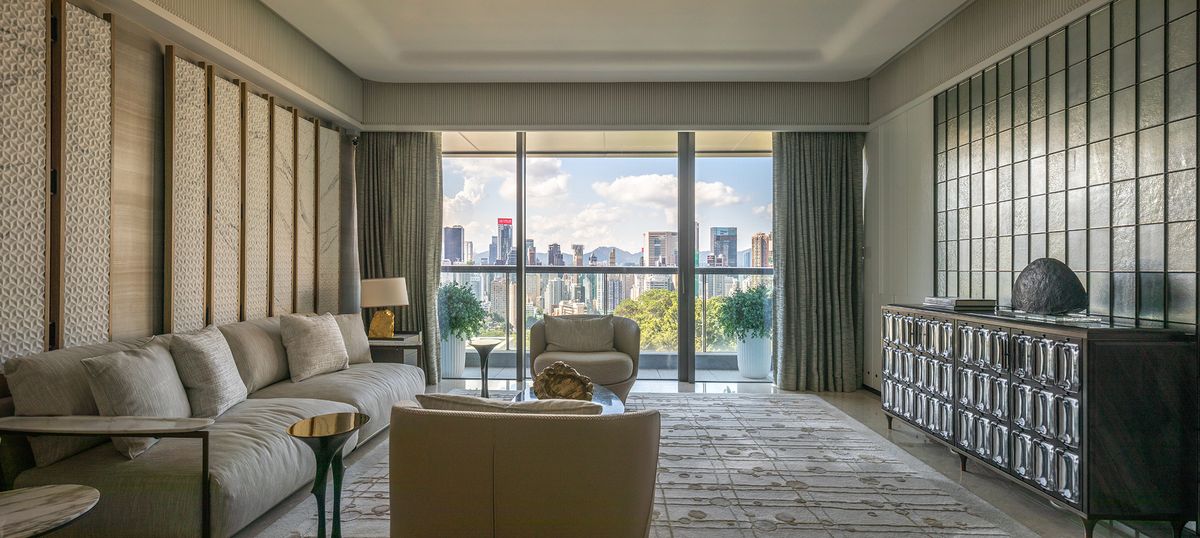Human Quarry
- Painting (Painting)
55 x 42 inches
Leslie Shows
Human Quarry is a large work on paper by Leslie Shows made of a combination of acrylic paint and collage. Both through its title and formally—through how the shapes in the composition resemble a mountain or natural formation—the piece relays us to a mineral quarry or a deep mining pit where materials are extracted. Interspersed among the block-like figures and rocky textures, we also see several human silhouettes, either cut-out, or as if they were whited out by a shining light, or lost in the shadows. There’s additional evidence of human presence: architectural features such as steps and a window, and symmetrical forms that resemble an X-ray scan or an inkblot from a Rorschach test. These references are collisions of opposing forces—positive and negative space, light and dark, presence and absence, consciousness and the subconscious. Together they comprise a complex excavation that somehow equates human experience with geological time, as if the spectral figures were layers of sediment from civilizations past.
Although at first Leslie Shows’ work might read as abstract compositions, a close inspection reveals her expanded approach to painting and the deeper connections she has forged between her practice and the realms of geology, the passing of time and the imaginary. Her works are usually large in scale and materially rich, deftly combining a lush and diverse arsenal including sand, paint, metal, fabrics, plexiglass, ink, and collage among others. Whether hung sideways in diamond-like shapes, or laden with folds, fragments and textures that stretch and drip, her work is rarely confined within the limits of a frame. A key aspect of Shows’ practice is an interest in the various ways in which we relate to the natural world. She has taken inspiration from the mineral pyrite, or iron pyrite, also known as fool’s gold; from water formations from the faces of rocks; and even from calcified mining ruins that the artist remembers from her childhood spent in Juneau, Alaska. Whether suggesting forms from nature like beehives, or emulating the textures of crystals and marble or the shapes of minerals, each piece connects us to a place, a landscape, real or imagined.
Colors:
Related works sharing similar palette

© » KADIST
Katinka Bock
2008Like with other works of the artist, with First Piano Katinka Bock tried to go against the rules of use of clay, that is, by forcing the material to the extreme, and transferring the resulting elements into a cubic shaped volume...

© » ARTS EQUATOR
Yangon's well loved Palace of Literature (via The Myanmar Times) | ArtsEquator Thinking and Talking about Arts and Culture in Southeast Asia Articles October 3, 2018 The four storey yellow painted building with big masonry work of books in black and white pages for its motif loomed high at the corner of Merchant Road and 37th street...

© » KADIST
Vivian Suter
Vivian Suter paints her canvases and then allows them to come in contact with natural elements...

© » KADIST
Olaf Breuning
2002In the work We only move wehen something changes !!!, Olaf Breuning composes a portrait of posed antiglobalization protesters, each wearing clown noses, inside of a scene reminiscent of an event...

© » ART & OBJECT
Famed Studio of Gaugin and Modigliani to Be Restored| Art & Object Skip to main content Subscribe to our free e-letter! Webform Your Email Address Role Art Collector/Enthusiast Artist Art World Professional Academic Country USA Afghanistan Albania Algeria American Samoa Andorra Angola Anguilla Antarctica Antigua & Barbuda Argentina Armenia Aruba Ascension Island Australia Austria Azerbaijan Bahamas Bahrain Bangladesh Barbados Belarus Belgium Belize Benin Bermuda Bhutan Bolivia Bosnia & Herzegovina Botswana Bouvet Island Brazil British Indian Ocean Territory British Virgin Islands Brunei Bulgaria Burkina Faso Burundi Cambodia Cameroon Canada Canary Islands Cape Verde Caribbean Netherlands Cayman Islands Central African Republic Ceuta & Melilla Chad Chile China Christmas Island Clipperton Island Cocos (Keeling) Islands Colombia Comoros Congo - Brazzaville Congo - Kinshasa Cook Islands Costa Rica Croatia Cuba Curaçao Cyprus Czechia Côte d’Ivoire Denmark Diego Garcia Djibouti Dominica Dominican Republic Ecuador Egypt El Salvador Equatorial Guinea Eritrea Estonia Eswatini Ethiopia Falkland Islands Faroe Islands Fiji Finland France French Guiana French Polynesia French Southern Territories Gabon Gambia Georgia Germany Ghana Gibraltar Greece Greenland Grenada Guadeloupe Guam Guatemala Guernsey Guinea Guinea-Bissau Guyana Haiti Heard & McDonald Islands Honduras Hong Kong SAR China Hungary Iceland India Indonesia Iran Iraq Ireland Isle of Man Israel Italy Jamaica Japan Jersey Jordan Kazakhstan Kenya Kiribati Kosovo Kuwait Kyrgyzstan Laos Latvia Lebanon Lesotho Liberia Libya Liechtenstein Lithuania Luxembourg Macao SAR China Madagascar Malawi Malaysia Maldives Mali Malta Marshall Islands Martinique Mauritania Mauritius Mayotte Mexico Micronesia Moldova Monaco Mongolia Montenegro Montserrat Morocco Mozambique Myanmar (Burma) Namibia Nauru Nepal Netherlands Netherlands Antilles New Caledonia New Zealand Nicaragua Niger Nigeria Niue Norfolk Island Northern Mariana Islands North Korea North Macedonia Norway Oman Outlying Oceania Pakistan Palau Palestinian Territories Panama Papua New Guinea Paraguay Peru Philippines Pitcairn Islands Poland Portugal Puerto Rico Qatar Romania Russia Rwanda Réunion Samoa San Marino Saudi Arabia Senegal Serbia Seychelles Sierra Leone Singapore Sint Maarten Slovakia Slovenia Solomon Islands Somalia South Africa South Georgia & South Sandwich Islands South Korea South Sudan Spain Sri Lanka St...

© » FLASH ART
Mark Bradford "Nobody Knows the Trouble I've Seen" Hauser & Wirth / Monaco | | Flash Art Flash Art uses cookies strictly necessary for the proper functioning of the website, for its legitimate interest to enhance your online experience and to enable or facilitate communication by electronic means...

© » THEARTNEWSPER
The Metropolitan Museum will repatriate 16 Khmer sculptures to Cambodia and Thailand Art market Museums & heritage Exhibitions Books Podcasts Columns Technology Adventures with Van Gogh Search Search Antiquities trafficking news The Metropolitan Museum will repatriate 16 Khmer sculptures to Cambodia and Thailand The museum had been pressured and petitioned for years to return objects tied to smuggler Douglas Latchford Theo Belci 15 December 2023 Share Two antiquities with ties to the late dealer Douglas Latchford—the Bodhisattva Avalokiteshvara Seated in Royal Ease from the tenth or eleventh century (left) and the Head of Avalokiteshvara, the Bodhisattva of Infinite Compassion from the tenth century (right)—will be repatriated by the Metropolitan Museum of Art Metropolitan Museum of Art The Metropolitan Museum of Art has begun the repatriation process for 16 sculptures previously held in its permanent collection, returning 14 to Cambodia and two to Thailand...

© » KADIST
Zhang Zhenyu
2018In DUST 171217 Zhang Zhenyu uses fragments of dust collected across the city, and then creates dark abstract paintings, repetitively gluing the material to the canvas, applying up to 30 or 100 layers and sanding until he arrives at a smooth surface...

© » WALLPAPER*
Tour La Maison Blanche by Cream | Wallpaper (Image credit: Cream) By Ellie Stathaki published 17 December 2023 Architect Antony Chan’s newest project, La Maison Blanche, is an apartment transformation tailor made for the scheme's location and long vistas – as it sits nestled high above the rooftops in the mid-level area of Hong Kong...











